Was ist Mitarbeiteranerkennung: Definition, Arten, Wichtigkeit und Ideen
Die Wertschätzung der Mitarbeiter fördert die Mitarbeiterbindung und die Produktivität. Entdecken Sie die Vorteile und Ideen für die Anerkennung der wertvollen Beiträge Ihres Teams.
Auf dieser Seite
- Was ist die Wertschätzung der Mitarbeiter?
- Anerkennung vs. Wertschätzung: Was ist der Unterschied?
- Warum ist die Wertschätzung der Mitarbeiter wichtig: Statistiken zur Rechtfertigung
- Arten der Wertschätzung von Mitarbeitern
- Strategien zur Wertschätzung der Mitarbeiter
- Einführung eines Programms zur Wertschätzung der Mitarbeiter
- Wie können Sie die Wirkung Ihres Programms zur Mitarbeiterwertschätzung messen?
- Verbessern Sie Ihr Programm zur Mitarbeiterbewertung mit Empuls
- Beispiele für erfolgreiche Programme zur Wertschätzung von Mitarbeitern
- Vergessen Sie nicht: Wertschätzung ist kein Ereignis, sondern eine Kultur
Die Mitarbeiter sind die treibende Kraft hinter jedem Meilenstein, den ein Unternehmen erreicht. Eine wettbewerbsfähige Bezahlung und gute Sozialleistungen ziehen zwar Talente an, sind aber keine Garantie für Loyalität. Was oft den Unterschied ausmacht, ist, wie wertvoll sich die Mitarbeiter fühlen, sobald sie Teil des Teams sind. Ein gut strukturierter Ansatz zur Wertschätzung kann gelegentliches Lob in eine beständige Erfahrung verwandeln, die Vertrauen und Loyalität aufbaut.
Hier kommen Programme zur Wertschätzung der Mitarbeiter ins Spiel. Diese Initiativen gehen über allgemeine Danksagungen oder jährliche Auszeichnungen hinaus. Es handelt sich um gezielte, kontinuierliche Bemühungen, Beiträge anzuerkennen, Erfolge zu feiern und den Mitarbeitern auf eine Art und Weise Wertschätzung zu zeigen, die für sie von Bedeutung ist.
In diesem Leitfaden erfahren Sie, was Mitarbeiterwertschätzung wirklich bedeutet, welche verschiedenen Arten von Mitarbeiterwertschätzung es gibt und warum sie eine Schlüsselrolle bei der Mitarbeiterbindung und -moral spielt. Außerdem finden Sie praktische Ideen, wie Sie Ihren Mitarbeitern Wertschätzung entgegenbringen können, und Tipps, wie Sie wirksame Wertschätzungsprogramme entwickeln, die zu Ihrer Unternehmenskultur passen.
Was ist die Wertschätzung der Mitarbeiter?
Unter Wertschätzung versteht man die Anerkennung der Mitarbeiter und ihre Belohnung für ihren Beitrag am Arbeitsplatz. Anstatt sich nur auf ihre Leistung zu konzentrieren, wird ihr Wert als Mitglied des Teams und als Mensch gewürdigt. Er wird am ersten Freitag im März begangen.
Anerkennung vs. Wertschätzung: Was ist der Unterschied?
Obwohl beides oft Hand in Hand geht, sind Anerkennung und Wertschätzung nicht das Gleiche. Anerkennung hebt in der Regel bestimmte Aktionen oder Ergebnisse hervor - wie das Erreichen von Zielen oder den Abschluss eines großen Projekts. Sie ist oft an die Leistung geknüpft und kann öffentlich oder formell sein.
Wertschätzung hingegen ist etwas Persönliches. Hier geht es darum, jemanden für das zu schätzen, was er ist, und nicht nur für das, was er tut. Ein kurzes "Dankeschön" für die ständige Zuverlässigkeit oder eine Notiz für den positiven Einfluss - das ist gelebte Wertschätzung.
Ein starkes Belohnungssystem hält beides im Gleichgewicht. Anerkennung spornt zu Leistung an, während Wertschätzung die Beziehungen stärkt. Zusammen tragen sie dazu bei, einen Arbeitsplatz zu schaffen, an dem sich die Menschen wirklich wertgeschätzt fühlen.
Warum ist die Wertschätzung der Mitarbeiter wichtig: Statistiken zur Rechtfertigung
Die Anerkennung von Mitarbeitern ist seit jeher ein grundlegender Aspekt einer effektiven Unternehmensführung. Da sich jedoch der Wettbewerb um Talente verschärft, werden die Methoden, mit denen Unternehmen ihre Wertschätzung für ihre Mitarbeiter zum Ausdruck bringen, immer wichtiger.
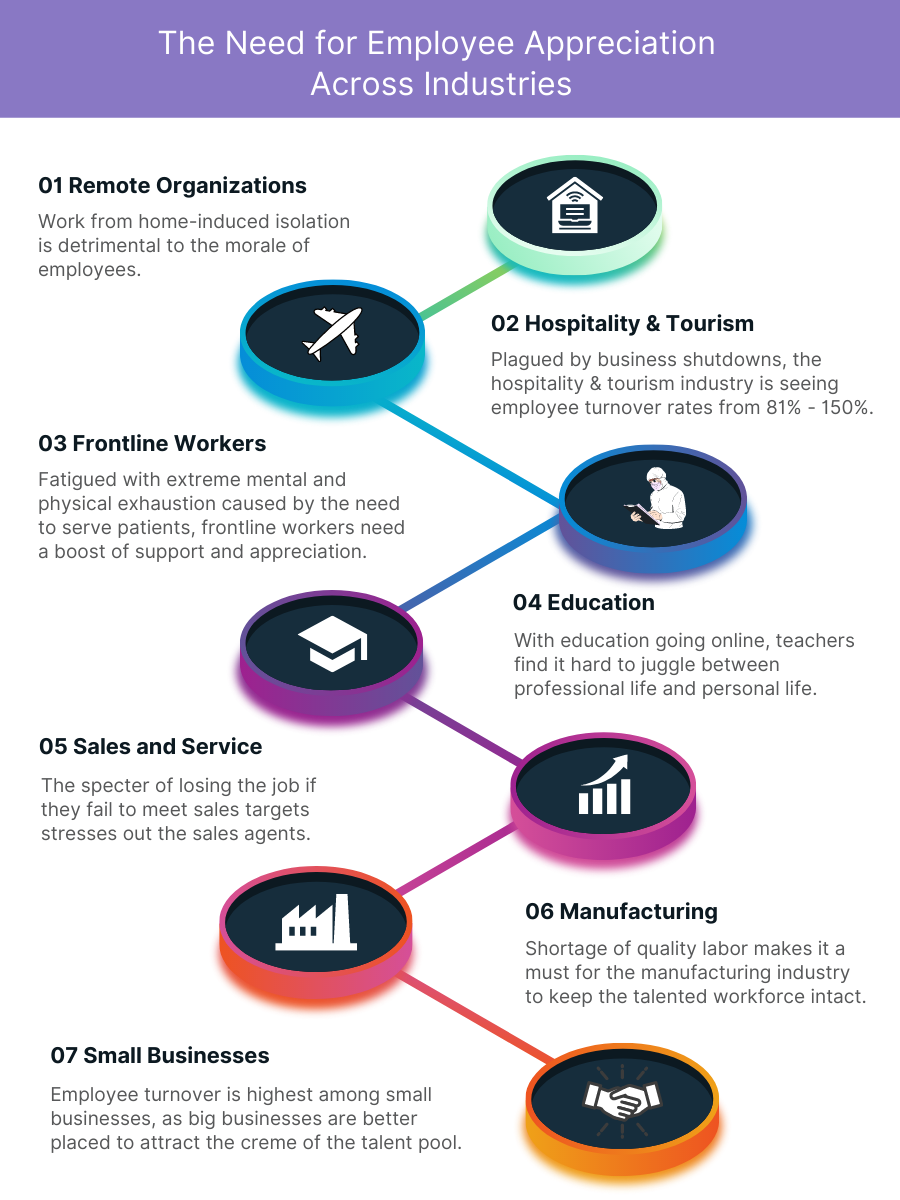
1. Rekrutierung
- Laut SHRM gaben 56 % der Personalleiter an, dass Anerkennungs- oder Wertschätzungsprogramme für Mitarbeiter ihnen helfen, Top-Talente zu rekrutieren. Wenn die Mitarbeiter zufriedener sind und bessere Erfahrungen machen, sind sie eher bereit, als Botschafter der Arbeitgebermarke aufzutreten.
- Die Menschen wollen mit Arbeitgebern zusammenarbeiten, die ihre Mitarbeiter anerkennen und wertschätzen - das ist eine der 10 wichtigsten Arbeitgeber-Eigenschaften nach denen sie suchen. Sie suchen nach Unternehmen, die ehrlich sind und Integrität besitzen.
2. Vorratsspeicherung
- Die Wertschätzung der Mitarbeiter führt zu einer besseren Mitarbeiterbindung und einer geringeren Fluktuation. In der Tat, 70% der Personalverantwortlichen gaben an, dass die Anerkennung von Mitarbeitern zur Mitarbeiterbindung beiträgt.
- Die Anerkennung und Wertschätzung von Mitarbeitern kann deren Loyalität erheblich steigern und die Fluktuationsrate senken.
- Für 55 % der Arbeitnehmer war mangelnde Anerkennung die Hauptursache für ihre Entscheidung, den Arbeitsplatz zu wechseln. Noch aufschlussreicher ist, dass 69 % geblieben wären, wenn ihr Arbeitgeber mehr Belohnungen und Anerkennung geboten hätte.
- 53 % der Arbeitnehmer gaben an, dass das Gefühl der Wertschätzung durch ihren direkten Vorgesetzten ihnen helfen würde, länger in ihrem Unternehmen zu bleiben.
3. Produktivität
- Laut einer Umfrage des Personaldienstleistungsunternehmens Alight gaben geschätzte Mitarbeiter mit 7-fach höherer Wahrscheinlichkeit an, sich bei der Arbeit zu engagieren, als Mitarbeiter, die keine Wertschätzung erfahren.
- 56% der Mitarbeiter, die sich in ihrem Unternehmen zugehörig fühlten, zeigten eine höhere Gesamtarbeitsleistung.
- Laut einem Bericht der Universität Oxfordsind glückliche Arbeitnehmer 13 % produktiver bei der Arbeit.
- 84% der Personalverantwortlichen gaben an, dass die Wertschätzung der Mitarbeiter einen positive Auswirkungen auf das Engagement der Mitarbeiter.
4. Arbeitsbeziehungen
- 87% gaben an, dass Programme zur Wertschätzung der Mitarbeiter die Beziehungen am Arbeitsplatz verbessern und die Unternehmenskultur fördern.
- 41% der Arbeitnehmer wünschen sich mehr Wertschätzung von ihren unmittelbaren Kollegen.
5. Verwaltung
- Gallup sagt, dass die Fähigkeit von Managern, Teammitglieder zu inspirieren, eine der wichtigsten Führungsqualitäten ist, die leistungsstarke Teams antreibt. Diese Fähigkeit umfasst nicht nur die Vermittlung von Vision und Mission, sondern auch die Anerkennung und Wertschätzung von Mitarbeitern für außergewöhnliche Leistungen.
- Führungskräfte selbst betrachten Wertschätzung als einen Schlüsselfaktor für ihr eigenes Glück. 83 % der leitenden Angestellten halten Wertschätzung für entscheidend für ihre Arbeitszufriedenheit.
- Anerkennung und Wertschätzung korrelieren auch mit dem Gefühl der Bedeutung für ein Team. Dieselbe Gallup-Studie ergab, dass 74 % der US-Beschäftigten, die angaben, dass ihre Teams gelobt werden, zustimmten, dass die Anerkennung ihnen das Gefühl gab, dass ihre Aufgaben wertvoll und nützlich waren.
6. Vertrauen und Moral der Mitarbeiter
- Nach Angaben von Netsuiteist fast ein Drittel des Wunsches eines Arbeitnehmers, bei einem Unternehmen zu bleiben, das Ergebnis des Vertrauens zu seinem Chef.
- Derselben Studie zufolge glauben 78 % der Arbeitnehmer, dass die Art und Weise, wie ein Unternehmen seine Mitarbeiter behandelt, einer der besten Indikatoren für seine Vertrauenswürdigkeit ist.
- Zwei Drittel der Mitarbeiter in "angemessen gelobten Teams", so Gallup, stimmten stark zu, dass sie ihren Kollegen vertrauten.
- Nach Angaben von 82% der Personalverantwortlichen fördert die Wertschätzung der Mitarbeiter die Zufriedenheit der Beschäftigten. Diese Programme verbessern auch die Unternehmenskultur (86 %) und die Erfahrungen der Mitarbeiter (89 %).
Es ist daher nicht verwunderlich, dass die Liste der Branchen, unabhängig von ihrer Kernkompetenz, die von der Bedeutung der Wertschätzung der Mitarbeiter begeistert sind, endlos ist.
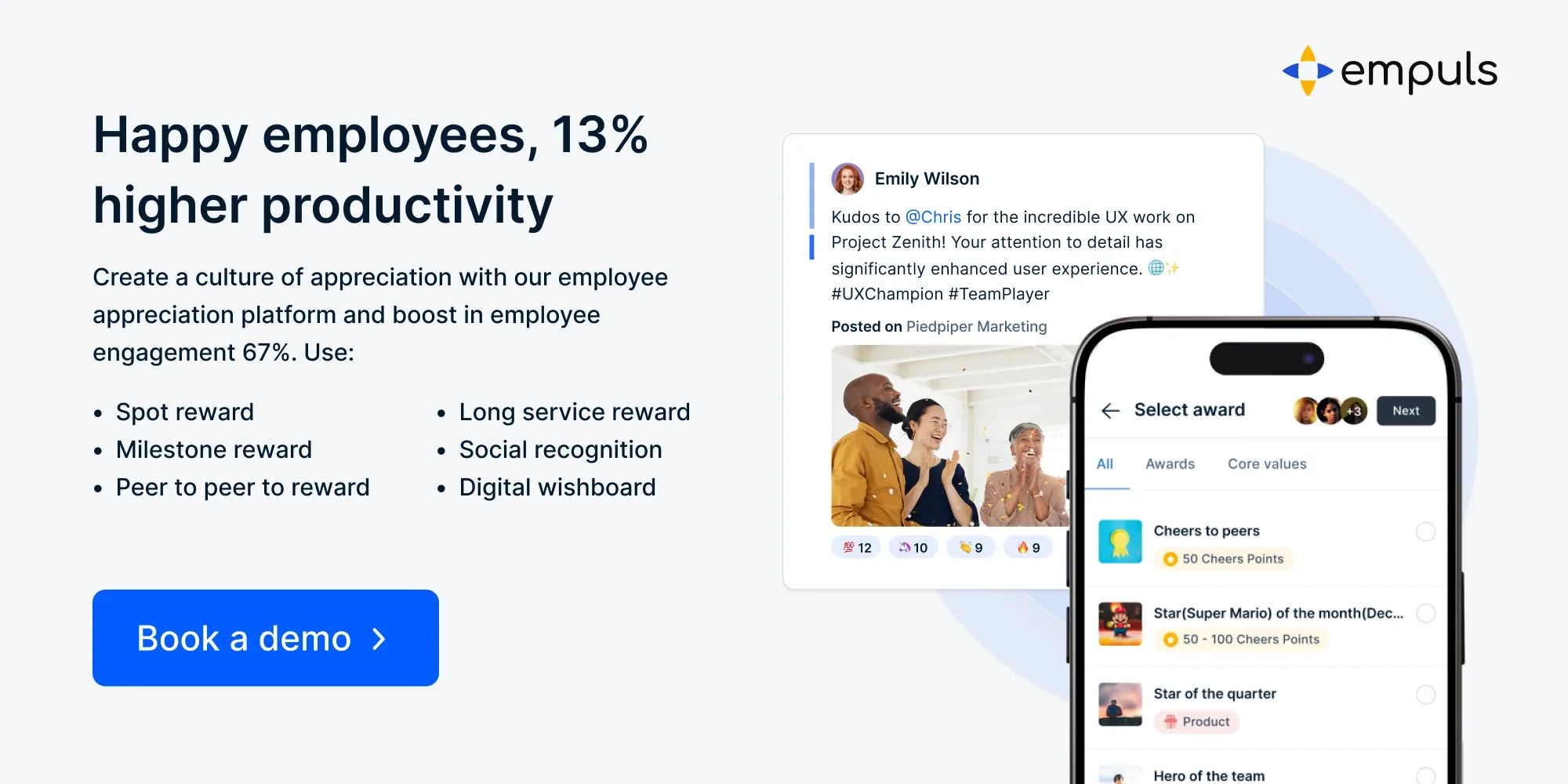
Arten der Wertschätzung von Mitarbeitern
Obwohl die Wertschätzung der Mitarbeiter viele Formen annehmen kann - von sofortigen bis hin zu geplanten Programmen - kann man sie grob in drei Hauptkategorien einteilen.
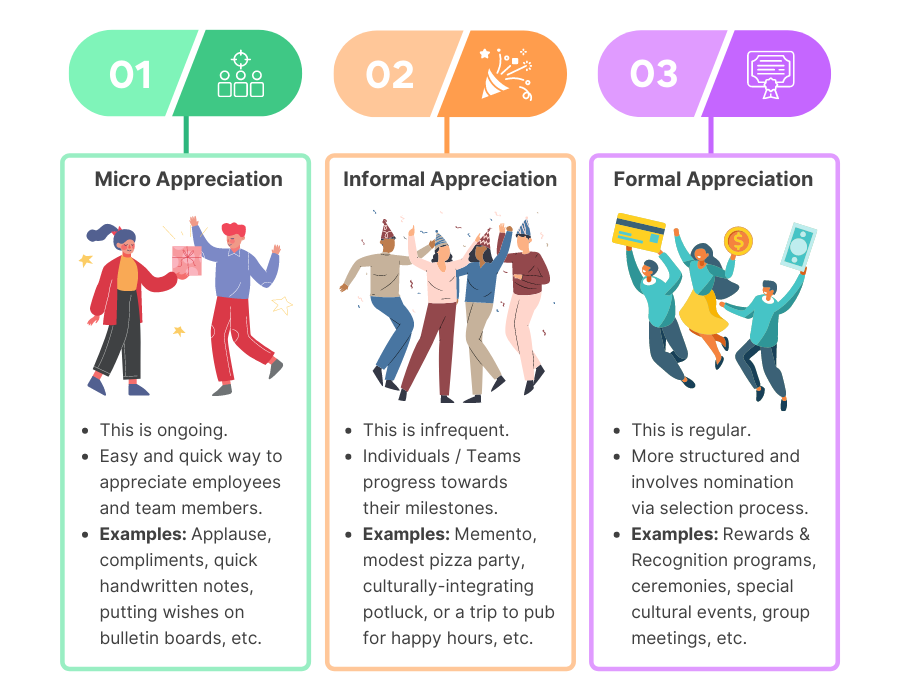
1. Mikro-Aufwertung
Mikro-Wertschätzung, auch bekannt als alltägliche Wertschätzung, ist eine häufige und kontinuierliche Wertschätzung. Sie erfolgt in der Regel in Form von handschriftlichen Notizen, Karten, Aushängen von Wünschen am schwarzen Brett oder anderen Maßnahmen, die eine schnelle und einfache Wertschätzung der Mitarbeiter ermöglichen.
Ein einfaches Dankesschreiben kann einem Mitarbeiter das Gefühl geben, dass er täglich geschätzt wird.
Auch wenn sie weniger pompös ist, eignet sich die Mikro-Wertschätzung am besten, um die Werte des Unternehmens häufig zu unterstützen und den Mitarbeitern das Gefühl zu geben, dass sie geschätzt werden, ohne dass dafür viel Zeit und Ressourcen aufgewendet werden müssen.
2. Informelle Wertschätzung
Informelle Wertschätzung hingegen bezieht sich auf spontane und persönliche Äußerungen der Dankbarkeit und Anerkennung von Kollegen und Vorgesetzten. Dies kann mündliche Danksagungen, handschriftliche Notizen und kleine Geschenke umfassen.
Informelle Anerkennung ist unmittelbarer und kann jederzeit ausgesprochen werden, um alltägliche Bemühungen und Leistungen zu würdigen. Sowohl formelle als auch informelle Anerkennung sind wichtig für eine ausgewogene Anerkennungsstrategie, die den Mitarbeitern das Gefühl gibt, geschätzt zu werden.
3. Formale Wertschätzung
Formelle Wertschätzung bezieht sich auf strukturierte Anerkennungsprogramme und Belohnungen, die in der Regel von der Geschäftsleitung oder der Personalabteilung durchgeführt werden. Diese Programme können Auszeichnungen für den Mitarbeiter des Monats/Quartals/Jahres, Prämien und Beförderungen umfassen.
Die formelle Anerkennung ist oft Teil eines größeren Programms zur Wertschätzung der Mitarbeiter und dient der systematischen Anerkennung von Mitarbeitern für ihre bedeutenden Leistungen und Beiträge.
4. Monetäre und nichtmonetäre Wertsteigerung
Monetäre Wertschätzung bezieht sich auf Belohnungen, die einen finanziellen Wert haben, wie Prämien, Gehaltserhöhungen und Geschenkkarten. Diese Arten von Belohnungen sind greifbar und können den Mitarbeitern sofortige Befriedigung verschaffen. Monetäre Belohnungen werden häufig eingesetzt, um außergewöhnliche Leistungen, bedeutende Erfolge oder Meilensteine zu würdigen.
Nicht-monetäre Wertschätzung hingegen bezieht sich auf Belohnungen, die keinen direkten finanziellen Wert haben, wie z. B. öffentliche Anerkennung, zusätzliche Freizeit und Möglichkeiten für berufliches Wachstum und Entwicklung.
Nicht-monetäre Wertschätzung kann ebenso viel dazu beitragen, dass sich die Mitarbeiter wertgeschätzt und anerkannt fühlen. Sie trägt den intrinsischen Motivationen der Mitarbeiter Rechnung, wie dem Wunsch nach Anerkennung, persönlicher Entwicklung und einem Gefühl der Zugehörigkeit.
Strategien zur Wertschätzung der Mitarbeiter
Da es sich bei der Wertschätzung um eine Kultur und damit um eine ganzjährige Aktivität handelt, muss darauf geachtet werden, dass sie Sie nicht ein Bein und einen Arm kostet. Gleichzeitig sollten Ihre Wertschätzungsbemühungen nicht ihre angeborene Fähigkeit verfehlen, die Mitarbeiter zu überwältigen und zu erfreuen.
1. Kleine, einfache, aber wirkungsvolle Gesten
Kostengünstige, wirkungsvolle Wege, Mitarbeitern Wertschätzung zu zeigen sind durchaus in der Lage, Mitarbeiter wertzuschätzen.
➼ Sagen Sie öfter danke: Eine Fülle von Forschung schreien laut, dass Wertschätzung die Menschen glücklich macht und ihnen ein Gefühl der Wertschätzung vermittelt. Die Gesamtausrichtung Ihrer Wertschätzungsstrategie sollte daher darauf abzielen, Wege zu finden, um Ihren Mitarbeitern häufiger Danke zu sagen.
Machen Sie aufrichtige Komplimente, um Ihre Dankbarkeit zu zeigen, wenn sich die Gelegenheit ergibt. Das sollte mehr als eine Richtlinie, sondern eine Gewohnheit sein. Es ist daher nicht überraschend, dass drei Viertel der Fachkräfte angaben, dass ein einfaches "Danke" ausreicht, damit sie sich anerkannt fühlen.
➼ Richten Sie einen Unternehmens-Dankes-Feed ein: Wie auch immer Sie Dinge intern ankündigen, ob mit einem Software-Tool oder einer detaillierten E-Mail-Kette, stellen Sie sicher, dass Sie einen Unternehmens-Dankes-Feed als wichtigen Teil Ihrer Kadenz einführen. Schon bald wird er zum Fundament Ihrer Kultur der Wertschätzung und Anerkennung werden.
Verteilen Sie einfache Zertifikate: Wenn ein Mitarbeiter eine besondere Leistung erbracht hat, wenn er "wirklich" den Elan gezeigt hat, über die Pflicht hinauszugehen und die tickende Uhr zu ignorieren, sollten Sie sich nicht scheuen, Zertifikate zu überreichen.
Natürlich sollten Sie nicht auf Teufel komm raus Zeugnisse verschenken. Aber in Maßen eingesetzt, können Zeugnisse das Gefühl des Stolzes und der Zufriedenheit der Mitarbeiter fördern.
Beachten Sie, dass Zertifikate nicht nur eine gute Geste sind. Wenn sie auf den Schreibtischen oder an den Wänden der Mitarbeiter verbleiben, können sie ein sichtbarer und dauerhafter Teil Ihrer Wertschätzungsaktion werden. Denken Sie an die "WALL Of FAME".
2. Taktische Auszeiten
Eine der größten Herausforderungen in der heutigen Zeit ist die mangelnde Vereinbarkeit von Beruf und Privatleben, die vor allem darauf zurückzuführen ist, dass man nicht genügend Zeit hat. Wenn Sie Ihren Mitarbeitern Zeit geben, sich zu entspannen und ihr Leben zu genießen, kann dies einen großen Unterschied für ihr Glück und ihr Wohlbefinden bedeuten.
➼ Erweiterte Pausen: Forschung weist vehement darauf hin, dass zusätzliche Bildschirm- oder Bewegungspausen während des Tages die Produktivität sogar steigern können. Der Grund dafür ist hinlänglich bekannt. Durch die Beschäftigung mit Aufgaben, die sich von den offiziellen unterscheiden, durchbrechen strategische Pausen die Monotonie in den Köpfen der Mitarbeiter.
Nickerchen: Wenn Arbeitnehmer rund um die Uhr arbeiten und sich tagtäglich abrackern, erreichen sie den Tiefpunkt, an dem das Gehirn herunterfährt und selbst das Offenhalten der Augen zu einem Kampf wird.
Um den Schwung der Produktivität aufrechtzuerhalten, sollten sie sich idealerweise ein paar Minuten in einem Erholungsraum ausruhen. Experten sind der Meinung, dass 10 bis 20 Minuten Nickerchen für einen schnellen und effektiven Wachheitsschub ausreichen.
3. Wertschätzung des Teams
Wie alle Unternehmensleiter sind auch Sie so gut wie Ihr Team. Es ist genauso wichtig, dem gesamten Team den Rücken zu stärken, wie einen einzelnen Mitarbeiter zum Blickfang zu machen.
➼ Gemeinsame Mittagessen und Getränke: Dies ist eine großartige Möglichkeit, um zwei Dinge zu erreichen: Erstens können die Mitarbeiter auf diese Weise der üblichen Büroroutine entfliehen. Zweitens tragen diese Ausflüge zur Teamarbeit bei, indem sie das Eis brechen und Freundschaften unter den Kollegen fördern.
➼ Erstellen Sie ein jährliches Jahrbuch: Auch wenn es altmodisch erscheinen mag, ist die Erstellung eines jährlichen Jahrbuchs ein wirkungsvolles Mittel, um die Wertschätzung der Mitarbeiter zu zeigen. Es hebt ihre harte Arbeit, ihre Leistungen und kreativen Ideen hervor und stellt sicher, dass ihre Beiträge in Erinnerung bleiben und geschätzt werden. Diese aufmerksame Geste kommt bei den Mitarbeitern immer sehr gut an.
Wählen Sie das beste Bild Ihrer Mitarbeiter aus, schreiben Sie eine einzigartige Zeile über sie und legen Sie es in ihre wertvollen Leistungen ein. Es ist ein ästhetisch schönes und angenehm haltbares Markenerinnerungsstück.
Erwähnen Sie Teams auf Ihrer "Über uns"-Seite: Da die traditionelle Führung von oben nach unten schwindet, wird ein stärker fördernder Ansatz zur Norm. Wenn Sie Ihren Teams einen Platz auf Ihrer Website einräumen, kann dies das Gefühl der Wertschätzung erheblich steigern. Mit kreativen Design-Tools ist dies eine kostengünstige Initiative, die es wert ist, ausprobiert zu werden, insbesondere zu besonderen Anlässen wie dem Tag der Mitarbeiteranerkennung.
➼ B esitzen Sie eine Mannschaftstrophäe: Gibt es eine bessere Anerkennung für ein Team als eine glänzende Trophäe mit dem eingravierten Namen des Teams? Erlauben Sie Ihren Mitarbeitern, ihn mit nach Hause zu nehmen oder ihn auf ihrem Schreibtisch aufzustellen. Empuls macht es Ihnen leichter, Ihre Mitarbeiter zu würdigen, indem Sie ihnen Wertabzeichen zur sofortigen Anerkennung geben.
4. Persönlich werden
Zwei Drittel der Arbeitnehmer sind sind eher bereit zwei Eintrittskarten für ein Konzert ihrer Wahl zu schenken, als den dreifachen Wert dieser Karten im Laufe eines Jahres auf ihren Gehaltsscheck aufgeschlagen zu bekommen. Die aufmerksame Geste eines persönlichen Geschenks spiegelt wider, wie sehr Sie die Mitarbeiter kennen und welchen positiven Einfluss sie auf das Unternehmen haben.
➼ Personalisierte Geschenke und Belohnungen: Bei der Personalisierung geht es nicht darum, den Namen des Mitarbeiters in ein Geschenk zu verpacken. Das ist passé. Was Personalisierung im Geiste und in den Buchstaben bedeutet, ist, dass das Geschenk bei den Mitarbeitern auf große Resonanz stoßen sollte.
Finden Sie heraus, welchen aktuellen Musiker sie mögen und überreichen Sie ihnen Eintrittskarten für seine Show. Finden Sie ihre Hobbys heraus und schenken Sie ihnen Gutscheine für diese Hobbykurse. Denken Sie daran: Wenn Geschenke zur Wertschätzung der Mitarbeiter nicht anstrebenswert sind, sind sie bloßes Beiwerk.
Fragen Sie nach dem Feedback: Es gibt keinen einfacheren Weg, Ihren Mitarbeitern das Gefühl zu geben, geschätzt zu werden, als sie einfach nach ihrer Meinung zu fragen. Allein das Wissen, dass sich das Unternehmen für ihre Meinung interessiert, kann bei ihnen ein positives Gefühl hervorrufen.
Der beste Weg, dies zu tun, ist Empuls ermöglicht, ist die Durchführung einer Umfrage. Zusammen mit dem gesteigerten Gefühl der Wichtigkeit unter den Mitarbeitern, übergibt sie den Puls dessen, was die Mitarbeiter denken und wollen.
5. Professionell werden
Forschung von EdAssist und der University of Phoenix ergab, dass 74 % der Arbeitnehmer der Meinung sind, dass die Unterstützung ihrer eigenen beruflichen Entwicklung in der Verantwortung ihres Unternehmens oder ihrer Führungskräfte liegt.
Wenn Sie Ihren Mitarbeitern innovative Weiterbildungsmöglichkeiten bieten, signalisieren Sie, dass Ihnen ihre Karriere wirklich am Herzen liegt und Sie an ihre Fähigkeiten glauben.
Bieten Sie Schulungs- und Lernmöglichkeiten an: Die Schulung von Mitarbeitern in den Fähigkeiten, die sie mit Leidenschaft betreiben, ist ein klassisches Beispiel für ein Win-Win-Szenario. Abgesehen davon, dass sie Sie dafür lieben und respektieren, dass Sie sie ernst nehmen, werden sie durch die Schulung besser ausgebildet und können ihre Aufgaben mit größerer Beherrschung und Perfektion ausführen, was zu einer allgemeinen betrieblichen Effizienz führt.
➼ Treffen Sie die Führungskräfte und stellen Sie ihnen Ihre Ideen vor: Die Chance, mit den Köpfen und Herzen des Unternehmens auf Tuchfühlung zu gehen, ist ein seltenes und glückliches Ereignis im Leben eines Mitarbeiters. Sie können dies jedoch noch steigern, indem Sie sich ein Beispiel an der Fernsehserie "Dragon's Den" nehmen und den Mitarbeitern die Möglichkeit geben, ihre Ideen und Visionen vor den Führungskräften vorzustellen.
Möglichkeiten zur Hospitation: Nicht selten klafft eine eklatante Lücke zwischen dem, was die Mitarbeiter sind, und dem, was ihre jeweilige Rolle von ihnen verlangt. Ein einfaches Mittel, um zu zeigen, wie die Arbeit tatsächlich aussieht, ist die Möglichkeit der Hospitation. Dies wird ihr Verständnis und ihr Wissen über die Aufgaben vertiefen, an denen sie interessiert sein könnten.
Denken Sie daran, dass es für die Person, die beschattet wird, sehr anstrengend ist. Es ist ratsam, den Zeitaufwand auf einen Tag pro Quartal zu begrenzen.
➼ Sc hreiben Sie eine LinkedIn-Empfehlung: Es mag kontraproduktiv klingen, aber eine gute LinkedIn-Empfehlung zu schreiben, hilft Ihnen, Mitarbeiter zu halten. Im Grunde genommen zeigt es, dass Sie den Fähigkeiten Ihrer Mitarbeiter vertrauen, und zwar nicht emotional, sondern rational, und dass Sie wirklich an ihrer beruflichen Entwicklung interessiert sind.
6. An die Öffentlichkeit gehen
Um talentierte Mitarbeiter zu halten, ist es wichtig, ein Umfeld zu schaffen, in dem sie sich wertgeschätzt fühlen und in dem sie einen Sinn in ihrer Arbeit finden.
Die Hierarchietheorie von Maslow weist darauf hin, die Wertschätzung öffentlich zu machen und andere wissen zu lassen, warum ein bestimmter Mitarbeiter wertgeschätzt wird.
➼ Social Media Shoutouts: Die einfachste, kostengünstigste, interaktivste und einprägsamste Methode, um Mitarbeitern öffentlich Anerkennung zu zollen, ist ein "Shoutout" in den sozialen Medien. Die Glückwunschkommentare lösen bei dem betreffenden Mitarbeiter zwangsläufig ein Wohlfühlgefühl aus.
➼ Erwähnungen in Ihren regelmäßigen Newslettern oder Zeitschriften: Eine weitere Möglichkeit, Ihre Wertschätzung öffentlich zu machen, ist eine Zusammenfassung in Ihrem Kunden-Newsletter oder Ihrer Kundenzeitschrift.
➼ Veröffentlichen Sie sie auf der Website des Unternehmens: Wenn Sie die Wertschätzung auf einer Website veröffentlichen, wird sie nicht nur öffentlich. Es macht sie für die Mitarbeiter enorm zufriedenstellend, da die Unternehmenswebsite für die meisten Menschen die erste offizielle Anlaufstelle ist.
7. Groß werden
Da Wertschätzung dazu beitragen kann, Ihre Marke aufzubauen und Top-Talente anzuziehen, ist es eine gute Idee, über Ihre Wertschätzungsbemühungen groß nachzudenken. Diese Initiativen mögen zwar etwas mehr kosten als üblich, aber sie sind die Investition auf jeden Fall wert.
➼ Einmalige Erfahrungen: Bloße Waren sind nicht gut genug. Sie sind allgegenwärtig, erprobt und erprobt, und man vergisst sie. Ein großartiges Erlebnis erzeugt das noch nicht empfundene Gefühl und wird dadurch unvergesslich.
Denken Sie an Geschenkgutscheine für Fallschirmspringen, Bungee-Jumping, Heißluftballonfahrten, einen Wochenendausflug an einen malerischen Ort oder sogar ein Autorennen. Ein Aufenthalt in einem Spa oder ein Yoga-Retreat ist eine gute Möglichkeit, die Seele Ihrer Mitarbeiter zu heilen.
➼ Jahresurlaub: Warum gönnen Sie nicht Ihrer gesamten Belegschaft einen Urlaub in der freien Natur? Das kann eine gute Idee für Mitarbeiter sein, die Ihnen treu geblieben sind und viel Zeit mit Ihnen verbracht haben. Denken Sie daran: Jahresurlaub (43%) ist die beliebteste Belohnung der Arbeitnehmer.
Einführung eines Programms zur Wertschätzung der Mitarbeiter
Ein Programm zur Wertschätzung der Mitarbeiter, das bei Ihren Mitarbeitern ankommt, erfordert eine sorgfältige Planung und Durchführung. Im Folgenden finden Sie die wichtigsten Schritte zur effektiven Umsetzung eines Programms zur Wertschätzung der Mitarbeiter, das einen echten Unterschied macht:
1. Klare Ziele setzen
Bevor Sie ein Programm starten, müssen Sie festlegen, was Sie erreichen wollen. Wollen Sie die Arbeitsmoral steigern, die Fluktuation verringern oder die Produktivität erhöhen? Klare Ziele helfen Ihnen bei der Gestaltung Ihres Programms und bei der Messung des Erfolgs.
Wenn Ihr Ziel beispielsweise darin besteht, die Mitarbeiterbindung zu verbessern, könnte sich Ihr Programm auf langfristige Belohnungen und Anerkennung konzentrieren.
2. Einbindung der Führung
Damit ein Anerkennungsprogramm erfolgreich ist, muss es von den Führungskräften stark unterstützt werden. Die Führungskräfte sollten das Programm nicht nur befürworten, sondern sich auch aktiv daran beteiligen.
Wenn die Mitarbeiter sehen, dass Wertschätzung auf allen Ebenen des Unternehmens geschätzt wird, sind sie eher bereit, sich selbst an dem Programm zu beteiligen. Die Beteiligung der Führungskräfte trägt auch dazu bei, den Ton anzugeben und die gewünschten Verhaltensweisen im gesamten Unternehmen vorzuleben.
3. Schaffung einer Anerkennungskultur
Der Aufbau einer Anerkennungskultur bedeutet, dass die Wertschätzung ein Teil der täglichen Routine wird und nicht nur ein gelegentliches Ereignis ist. Dazu gehört, dass die Anerkennung in regelmäßige Besprechungen, Leistungsbeurteilungen und sogar in lockere Gespräche integriert wird.
Wenn alle Mitarbeiter - nicht nur die Führungskräfte - zur Teilnahme an dem Programm ermutigt werden, entsteht eine Kultur, in der Wertschätzung ein natürlicher und ständiger Bestandteil des Arbeitsplatzes ist.
4. Kommunikation über das Programm
Sobald das Programm gestartet werden kann, ist eine klare Kommunikation der Schlüssel zum Erfolg. Stellen Sie sicher, dass alle Mitarbeiter verstehen, wie das Programm funktioniert, welche Verhaltensweisen und Leistungen anerkannt werden und wie sie teilnehmen können.
Regelmäßige Erinnerungen und Aktualisierungen sorgen dafür, dass das Programm im Gedächtnis bleibt, und fördern ein kontinuierliches Engagement.
5. Feedback einholen und Anpassungen vornehmen
Kein Programm ist von Anfang an perfekt. Regelmäßiges Feedback von den Mitarbeitern hilft Ihnen zu verstehen, was funktioniert und was verbessert werden muss.
Dies kann durch Umfragen, Fokusgruppen oder informelle Kontrollen geschehen. Seien Sie bereit, auf der Grundlage dieses Feedbacks Anpassungen vorzunehmen, um sicherzustellen, dass das Programm weiterhin den Bedürfnissen Ihrer Mitarbeiter und den Zielen Ihres Unternehmens entspricht.
Wie können Sie die Wirkung Ihres Programms zur Mitarbeiterwertschätzung messen?
Die Entwicklung und Umsetzung eines Programms zur Wertschätzung der Mitarbeiter ist nur der Anfang. Um die Wirksamkeit des Programms zu gewährleisten und es kontinuierlich zu verbessern, ist es unerlässlich, die Wirkung des Programms regelmäßig zu messen.
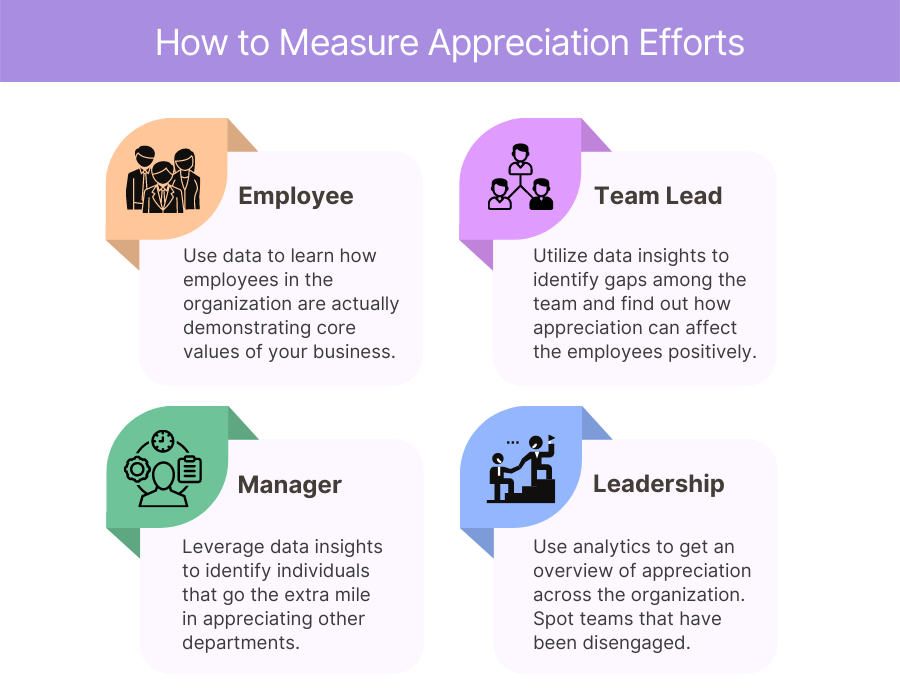
Hier erfahren Sie, wie Sie den Erfolg Ihrer Bemühungen um die Wertschätzung Ihrer Mitarbeiter bewerten können:
1. Mitarbeiter-Feedback
Eine der direktesten Möglichkeiten, den Erfolg Ihres Wertschätzungsprogramms zu messen, ist das Feedback Ihrer Mitarbeiter. Führen Sie regelmäßig Umfragen mit spezifischen, umsetzbaren Fragen durch, wie z. B.:
- Auf einer Skala von 1 bis 10, wie sehr fühlen Sie sich bei Ihrer Arbeit geschätzt?
- Welchen Aspekt des Wertschätzungsprogramms finden Sie am sinnvollsten?
- Welche Änderungen würden Sie sich im Anerkennungsverfahren wünschen?
Verwenden Sie eine Frage im Stil des Net Promoter Score (NPS) wie "Wie wahrscheinlich ist es, dass Sie einem Freund empfehlen würden, hier zu arbeiten", um die Gesamtzufriedenheit zu messen. Analysieren Sie das Feedback, um Trends und verbesserungswürdige Bereiche zu ermitteln.
2. Metriken für Bindung und Engagement
Die Verfolgung der Bindung und des Engagements ist entscheidend für das Verständnis der Auswirkungen des Programms. Verwenden Sie die folgenden Formeln, um diese Aspekte zu quantifizieren:
- Weiterbeschäftigungsquote: (Anzahl der Beschäftigten zu Beginn des Zeitraums/Anzahl der Beschäftigten am Ende des Zeitraums)×100
- Bewertung des Mitarbeiterengagements: Führen Sie Umfragen zum Mitarbeiterengagement durch und berechnen Sie die durchschnittliche Punktzahl für die wichtigsten Fragen zu Arbeitsmoral, Motivation und Arbeitszufriedenheit.
Vergleichen Sie diese Kennzahlen vor und nach der Einführung des Wertschätzungsprogramms. Eine höhere Bindungsrate und bessere Werte für das Engagement deuten in der Regel auf ein erfolgreiches Programm hin.
3. Beteiligungsquoten
Überwachen Sie die Teilnahmequoten an Ihren Wertschätzungsprogrammen. Zu den wichtigsten Kennzahlen, die Sie verfolgen sollten, gehören:
- Prozentsatz der anerkannten Mitarbeiter: (Gesamtzahl der Mitarbeiter/Anzahl der anerkannten Mitarbeiter)×100
- Teilnahme an Anerkennungsveranstaltungen: Verfolgen Sie die Teilnahme an Anerkennungsveranstaltungen oder -aktivitäten.
Niedrige Teilnahmequoten können darauf hindeuten, dass das Programm besser kommuniziert oder attraktiver belohnt werden muss. Hohe Teilnahmequoten deuten darauf hin, dass das Programm bei den Mitarbeitern gut ankommt und geschätzt wird.
4. Beobachtung von Verhaltensänderungen
Qualitative Beobachtung kann ebenfalls Aufschluss über den Erfolg des Programms geben. Stellen Sie sich oder Ihren Führungskräften die folgenden Fragen:
- Sind die Mitarbeiter eher bereit, neue Projekte zu übernehmen?
- Gibt es eine spürbare Verbesserung der Teamarbeit und der Zusammenarbeit?
- Beobachten Sie eine insgesamt positive Veränderung der Arbeitsplatzkultur?
Ziehen Sie außerdem die Einführung von 360-Grad-Feedback-Mechanismen in Betracht, bei denen Kollegen und Manager über beobachtete Verhaltensänderungen in Bezug auf Engagement und Wertschätzung berichten können.
5. Vergleich zwischen vorher und nachher
Um die Auswirkungen des Wertschätzungsprogramms klar zu erkennen, vergleichen Sie die wichtigsten Kennzahlen vor und nach der Umsetzung. Zum Beispiel:
- Engagement-Werte: Führen Sie in regelmäßigen Abständen Umfragen zum Engagement durch und vergleichen Sie die Ergebnisse, um festzustellen, ob eine spürbare Verbesserung eingetreten ist.
- Produktivitätsmetriken: Verfolgen Sie das Produktivitätsniveau anhand des Outputs pro Mitarbeiter oder der Projektabschlussraten.
- Kundenzufriedenheit: Messen Sie die Kundenzufriedenheit, denn zufriedene Mitarbeiter führen oft zu besseren Kundenerfahrungen.
Verbessern Sie Ihr Programm zur Mitarbeiterbewertung mit Empuls
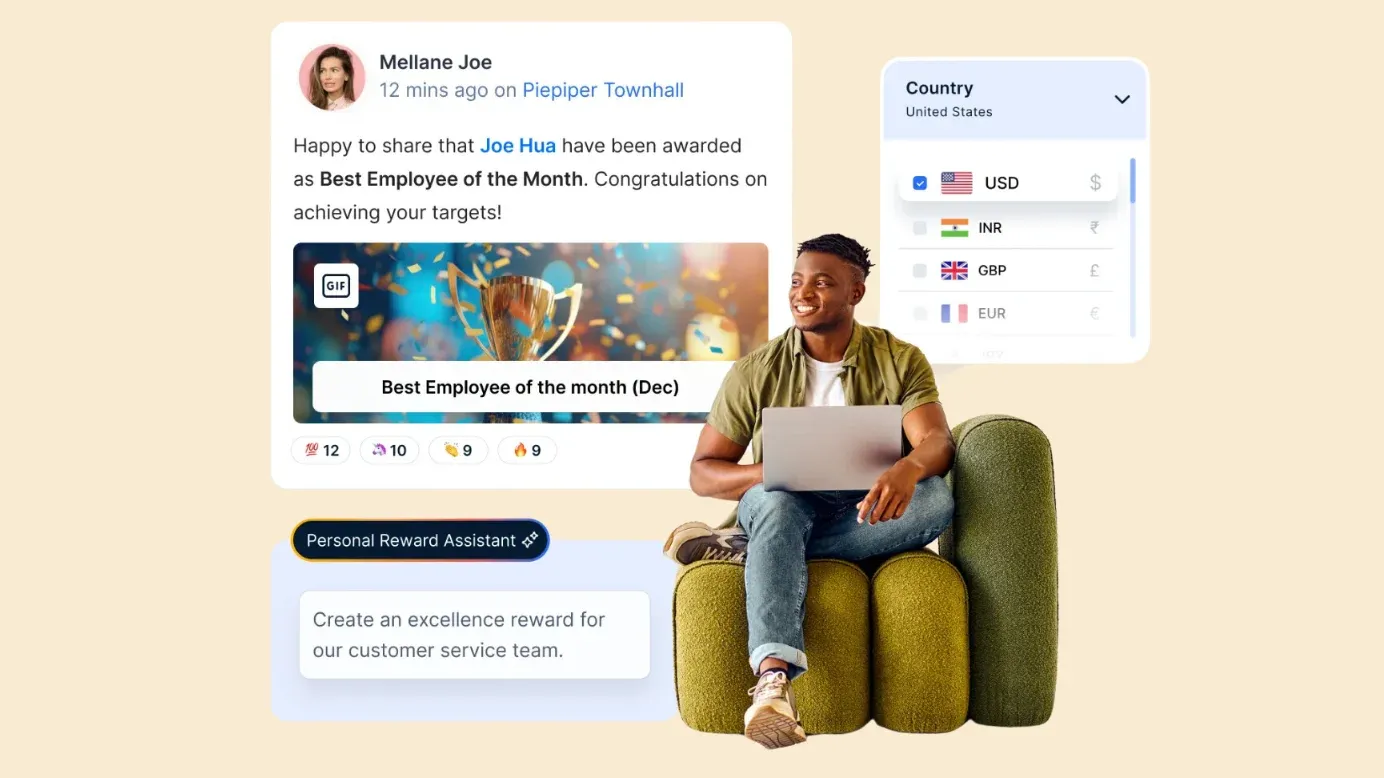
Mit Empuls können Sie über herkömmliche Anerkennungen hinausgehen und die Leistung von KI nutzen, um zeitnahe, umfassende und wirkungsvolle wirkungsvolle Anerkennungserlebnisse die zu echten Ergebnissen führen. Feiern Sie jeden Erfolg mit mehreren Belohnungsarten, automatisierten Workflows und vollständig anpassbaren Belohnungen - alles zugeschnitten auf Ihre individuellen Programmziele.
Warum Empuls wählen?
- KI-unterstützte Anerkennung: Steigern Sie das Engagement und die Bindung Ihrer Mitarbeiter mit zeitnaher und sinnvoller Anerkennung.
- Benutzerdefinierte Arbeitsabläufe: Automatisieren Sie Ihre Anerkennungsprogramme mit Workflows, die Nominatoren, Jury-Panels und Auslöser für besondere Ereignisse umfassen.
- Gebrandetes Erlebnis: Personalisieren Sie die Plattform mit dem Branding Ihres Unternehmens und individuellen Zertifikaten.
- Flexible Belohnungen: Bieten Sie sofortige Einlösung an und verwalten Sie Budgets mühelos mit einem integrierten Prämienshop.
Empuls macht es Ihnen leicht, Ihr Team auf eine Weise anzuerkennen und zu belohnen, die ankommt. Erhöhen Sie die Wertschätzung Ihrer Mitarbeiter und sehen Sie den Unterschied in Engagement und Bindung. Starten Sie mit Empuls!
Beispiele für erfolgreiche Programme zur Wertschätzung von Mitarbeitern
Um zu verdeutlichen, wie wirksam ein gut umgesetztes Programm zur Wertschätzung der Mitarbeiter sein kann, sehen wir uns einige Beispiele von Unternehmen an, die erfolgreich eine starke Wertschätzungskultur aufgebaut und aufrechterhalten haben.
1. Patagonien
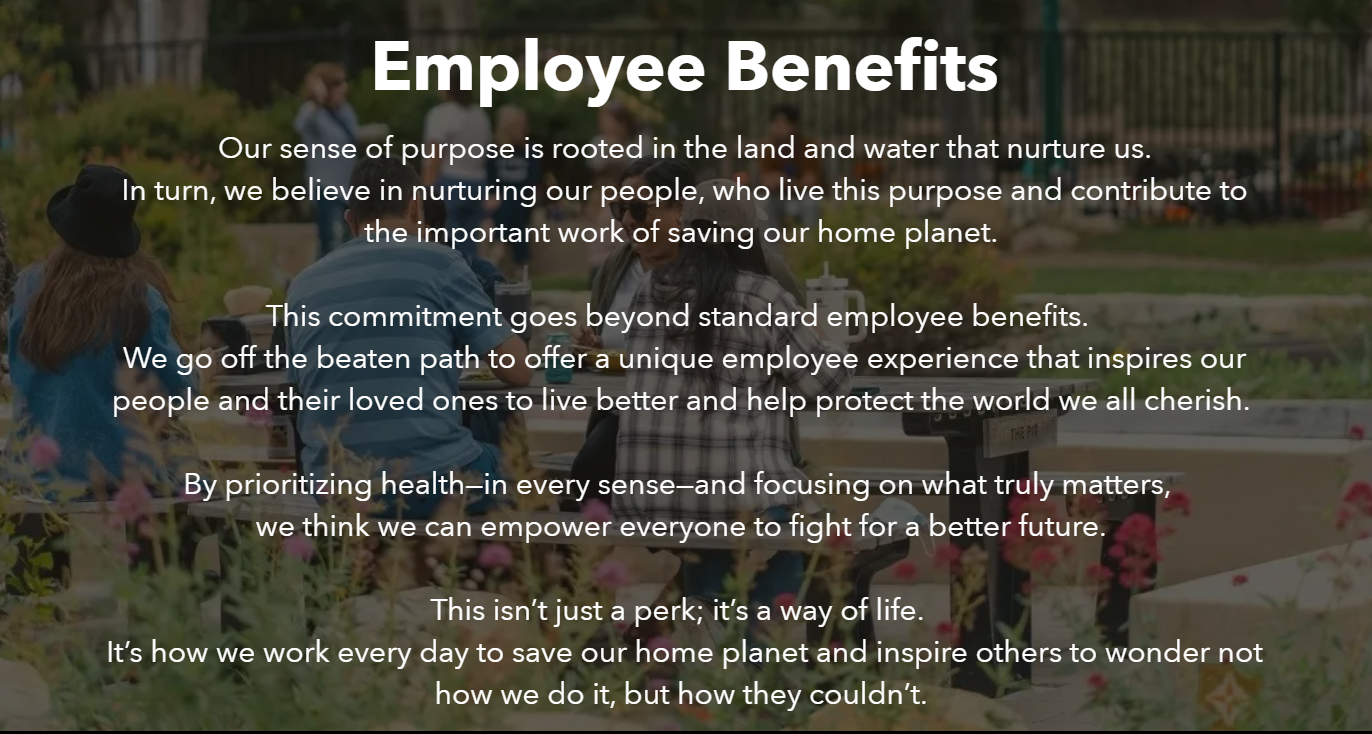
PatagoniaPatagonia, das renommierte Unternehmen für Outdoor-Bekleidung und -Ausrüstung, wird seit langem für sein Engagement nicht nur für ökologische Nachhaltigkeit, sondern auch für seine Mitarbeiter gefeiert. Die Bemühungen des Unternehmens um Wertschätzung sind tief in der Unternehmenskultur verwurzelt und spiegeln seine umfassendere Mission wider, sich um Menschen und den Planeten zu kümmern.
Eines der herausragenden Merkmale des Patagonia-Konzepts ist das "Let My People Go Surfing"Richtlinie. Diese einzigartige Leistung ermöglicht es den Mitarbeitern, während des Arbeitstages Pausen einzulegen, um zu surfen oder anderen Outdoor-Aktivitäten nachzugehen, wann immer die Bedingungen dafür gegeben sind.
Diese Regelung ist nicht nur eine Vergünstigung, sondern entspricht der Überzeugung des Unternehmens, dass eine starke Verbindung zur Natur die Kreativität, das Wohlbefinden und die Arbeitszufriedenheit fördert. Indem Patagonia seinen Mitarbeitern diese Flexibilität einräumt, zeigt das Unternehmen, dass es ihre Work-Life-Balance und ihre persönlichen Leidenschaften schätzt, was wiederum ein tiefes Gefühl der Loyalität und des Engagements für das Unternehmen fördert.
Darüber hinaus bietet Patagonia großzügige Zusatzleistungen, die über den Standard hinausgehen. Das Unternehmen bietet eine Kinderbetreuung vor Ort an, was den Stress für berufstätige Eltern mindert und ein Engagement für die Unterstützung von Familien zeigt. Patagonia bietet auch flexible Arbeitszeiten, die es den Mitarbeitern ermöglichen, ihr Privat- und Berufsleben besser zu vereinbaren.
Darüber hinaus fördert und unterstützt das Unternehmen die Leidenschaft seiner Mitarbeiter für Aktivismus und Umweltschutz, indem es bezahlte Freistellungen für ehrenamtliche Tätigkeiten in Umweltorganisationen anbietet.
Diese Bemühungen haben eine Arbeitsplatzkultur geschaffen, in der sich die Mitarbeiter mit dem Auftrag und den Werten des Unternehmens tief verbunden fühlen. Diese Verbundenheit hat zu einem hohen Engagement der Mitarbeiter, niedrigen Fluktuationsraten und einem starken Gemeinschaftsgefühl innerhalb des Unternehmens geführt.
Patagonias Ansatz zur Wertschätzung der Mitarbeiter ist ein Beweis dafür, wie die Ausrichtung von Unternehmenswerten auf das Wohlbefinden der Mitarbeiter einen florierenden Arbeitsplatz schaffen kann.
2. Southwest Airlines

Southwest Airlines ist ein weiteres hervorragendes Beispiel für ein Unternehmen, das Wertschätzung erfolgreich in seiner Kultur verankert hat. Southwest Airlines ist bekannt für seinen Kundenservice und seine engen Mitarbeiterbeziehungen und hat sich den Ruf eines Unternehmens erworben, das seine Mitarbeiter wirklich schätzt, was sich auch in seinen robusten Programmen zur Wertschätzung der Mitarbeiter widerspiegelt.
Eines der Schlüsselelemente des Konzepts von Southwest ist das Programm "Winning Spirit". Dieses formelle Anerkennungsprogramm wurde entwickelt, um Mitarbeiter anzuerkennen und zu belohnen, die in ihrer Rolle mehr als nur das Übliche tun.
Das Programm umfasst eine Vielzahl von Anerkennungsmöglichkeiten, von der Anerkennung durch Kollegen bis hin zu formellen Auszeichnungen für herausragende Leistungen. Der Schwerpunkt liegt auf der Anerkennung großer und kleiner Beiträge, was zur Förderung einer Kultur der kontinuierlichen Wertschätzung beiträgt.
Ein herausragendes Merkmal der Wertschätzungsbemühungen von Southwest ist die Initiative "Helden des HerzensProgramm". Im Rahmen dieser jährlichen Tradition können die Mitarbeiter ihre Kollegen nominieren, die einen außergewöhnlichen Beitrag zum Unternehmen geleistet haben. Die Gewinner werden nicht nur mit einer Überraschungsparty im Beisein der Unternehmensleitung gefeiert, sondern ihre Leistungen werden auch im gesamten Unternehmen bekannt gemacht.
Diese öffentliche Anerkennung stärkt nicht nur die Moral der einzelnen Mitarbeiter, sondern unterstreicht auch die Werte Teamwork, Engagement und Service, die für den Erfolg von Southwest von zentraler Bedeutung sind.
Southwest Airlines legt auch Wert auf eine Kultur des Spaßes und der Verbundenheit, was sich in den regelmäßigen unternehmensweiten Veranstaltungen und Aktivitäten zeigt. Diese Veranstaltungen in Verbindung mit den formellen Anerkennungsprogrammen schaffen ein Umfeld, in dem sich die Mitarbeiter geschätzt fühlen und motiviert sind, ihr Bestes zu geben.
Das Ergebnis dieser Bemühungen um Wertschätzung ist eine hoch engagierte Belegschaft mit einem starken Gefühl der Loyalität gegenüber dem Unternehmen. Southwest belegt bei der Mitarbeiterzufriedenheit durchweg einen Spitzenplatz und ist für seine niedrige Fluktuationsrate bekannt, die ein direktes Ergebnis seines Engagements für die Wertschätzung und Anerkennung seiner Mitarbeiter ist.
3. Quixy
Quixy, ein IT-Dienstleistungsunternehmen, hat sein Mitarbeiteranerkennungsprogramm durch die Integration von Empuls mit Microsoft Teams umgestaltet. Vor dieser Änderung hatte Quixy Probleme mit dem geringen Engagement seiner Mitarbeiter und dem Fehlen eines effektiven Belohnungssystems, was sich auf die Arbeitsmoral und Produktivität auswirkte.
Durch die Implementierung von Empuls bot Quixy eine zentrale Plattform für die Anerkennung von Leistungsträgern, den Austausch von organisatorischen Updates und das Sammeln von Feedback, was die Erfahrung der Mitarbeiter deutlich verbesserte.
Die Integration mit Microsoft Teams machte die Anerkennung noch nahtloser und ermöglichte es den Mitarbeitern, Feedback zu geben, Momente zu feiern und Kollegen zu belohnen, ohne ihren Arbeitsablauf zu verlassen. Das Team von Quixy konnte nun direkt in Teams an Watercooler-Chats teilnehmen, Leistungen anerkennen und an HR-Umfragen teilnehmen. Dies verbesserte die Zusammenarbeit und das Engagement im gesamten Unternehmen.
Durch die Integration von Empuls in Microsoft Teams konnte die Beteiligung der Mitarbeiter deutlich gesteigert werden. Die Arbeitsbelastung des HR-Teams wurde reduziert, da alle Anerkennungsaktivitäten auf einer Plattform zusammengefasst wurden, wodurch das Programm effizienter und zugänglicher wurde.
Dieses Beispiel verdeutlicht, wie die Integration eines Anerkennungstools in bestehende Arbeitsplattformen das Engagement steigern und eine nahtlose Erfahrung der Wertschätzung für Mitarbeiter schaffen kann.
4. Unternehmen im Gesundheitswesen
A globales digitales Gesundheitsunternehmen hat sein Mitarbeiter-Belohnungsprogramm mit Hilfe von Empuls überarbeitet, um das Engagement zu steigern und die Anerkennungsmaßnahmen zu rationalisieren. Zuvor war das Belohnungsprogramm manuell und ineffizient und bestand aus zahlreichen Meetings, E-Mail-Nachfassaktionen und Verzögerungen. Durch die Einführung von Empuls konnte das Unternehmen seinen Belohnungs- und Anerkennungsprozess automatisieren, ihn in bestehende Tools wie Slack und Zoho People integrieren und ein umfassenderes, zeitnahes Anerkennungssystem schaffen.
Die Plattform ermöglichte es den Mitarbeitern, ihre Kollegen auf einfache Weise zu nominieren und ihre Beiträge mit den zentralen Unternehmenswerten in Einklang zu bringen. Dies förderte die Anerkennung und stärkte die Verhaltensweisen, die für das Unternehmen am wichtigsten waren. Manager und Mitarbeiter waren in der Lage, Auszeichnungen und Wertschätzung abteilungsübergreifend zu verteilen, was dazu beitrug, Silos aufzubrechen und die Zusammenarbeit zu fördern.
Seit der Einführung von Empuls konnte das Unternehmen das Engagement seiner Mitarbeiter um das Zweifache steigern, wobei die aktive Beteiligung von 38 % auf 76 % anstieg. Auch die Verteilung von Auszeichnungen und Geschenkpunkten stieg innerhalb des ersten Jahres um beachtliche 380 %.
Durch das Programm fühlten sich die Mitarbeiter mehr wertgeschätzt und verbunden, was ein tieferes Gefühl der Zielsetzung und Zugehörigkeit förderte. Dieses Beispiel zeigt, wie ein gut durchgeführtes Anerkennungsprogramm das Engagement der Mitarbeiter erheblich steigern und eine lebendige Arbeitsplatzkultur schaffen kann.
Vergessen Sie nicht: Wertschätzung ist kein Ereignis, sondern eine Kultur
Auch wenn es ein Muss ist, den Tag der Wertschätzung für die Mitarbeiter zu feiern, ist es wichtig zu verstehen, dass die Wertschätzung der Mitarbeiter nicht an einen einzigen Tag gebunden sein sollte. Sie sollte als eine Bewegung entstehen, nicht als ein einzelnes Ereignis, und schließlich in einer lebendigen Unternehmenskultur gipfeln.
Der erste Schritt besteht darin, sich Gedanken über die Gestaltung Ihres eigenen Mitarbeiteranerkennungsprogramms zu machen und dabei Ihre allgemeinen Unternehmensziele und Ihre Mitarbeiterphilosophie im Auge zu behalten. Mit zahllosen kreativen Ideen und Methoden, um Ihre Mitarbeiter auf denkwürdige Weise zu würdigen, ist eine umfassende Plattform für Mitarbeiteranerkennung wie Empuls kann Ihren Willen und Ihr Handeln stärken, Ihre Mitarbeiter das ganze Jahr über zu würdigen.
FAQ's
Was ist eine gute Botschaft für die Wertschätzung der Mitarbeiter?
Hier ist eine durchdachte und vielseitige Botschaft zur Wertschätzung der Mitarbeiter:
"Wir danken Ihnen für Ihre harte Arbeit, Ihr Engagement und die positive Energie, die Sie in unser Team einbringen. Ihre Beiträge machen einen echten Unterschied, und wir schätzen wirklich alles, was Sie für unseren Erfolg tun. Ihre Bemühungen bleiben nicht unbemerkt, und wir sind dankbar, dass Sie zu unserem Team gehören. Machen Sie weiter so - Sie inspirieren uns alle!"
Wie kann man einem Mitarbeiter seine Wertschätzung ausdrücken?
Hier sind einige Möglichkeiten, wie Sie einem Mitarbeiter Ihre Wertschätzung ausdrücken können:
Direkt und aufrichtig: "Ich schätze wirklich die harte Arbeit und das Engagement, das Sie jeden Tag in unser Team einbringen. Ihre Bemühungen machen einen echten Unterschied, und ich bin dankbar für alles, was Sie tun."
Besondere Anerkennung: "Ihr innovativer Ansatz für [bestimmte Aufgabe/Projekt] war außergewöhnlich. Ich danke Ihnen für Ihre Kreativität und Ihr Engagement - Sie haben unseren Erfolg maßgeblich beeinflusst."
Den Wert anerkennen: "Sie sind ein so wichtiger Teil unseres Teams. Ihre Beiträge werden geschätzt und anerkannt, und wir sind froh, Sie an Bord zu haben."
Hervorhebung der Wirkung: "Ihre Arbeit an [bestimmte Aufgabe/Projekt] hat sich positiv auf unser Team und die Organisation als Ganzes ausgewirkt. Ich weiß die Zeit und die Mühe, die Sie investiert haben, sehr zu schätzen."
Motivierend: "Ihr Engagement und Ihre positive Einstellung inspirieren alle um Sie herum. Danke, dass Sie immer Ihr Bestes geben - Sie sind eine echte Bereicherung für unser Team."
Wie vermitteln Sie Ihren Mitarbeitern das Gefühl der Wertschätzung?
Damit sich die Mitarbeiter wertgeschätzt fühlen, sollten Sie ihre Leistungen regelmäßig mit persönlicher Anerkennung würdigen. Ermutigen Sie sie zu beruflichem Wachstum, indem Sie Schulungen und Aufstiegsmöglichkeiten anbieten. Übertragen Sie ihnen Verantwortung, bitten Sie sie um Feedback und reagieren Sie auf ihre Anregungen.
Meilensteine feiern und die Work-Life-Balance durch Flexibilität unterstützen. Fördern Sie ein positives Arbeitsumfeld mit Respekt, Inklusivität und sinnvollen Belohnungen. Zeigen Sie als Führungskraft Dankbarkeit und gehen Sie mit gutem Beispiel voran.
Wer ist für die Wertschätzung der Mitarbeiter verantwortlich?
Die Wertschätzung der Mitarbeiter ist eine gemeinsame Aufgabe innerhalb einer Organisation. Sie sollte sowohl von Vorgesetzten als auch von Kollegen initiiert werden. Vorgesetzte, Teamleiter und die Personalabteilung spielen eine wichtige Rolle bei der formellen Anerkennung, aber auch Kollegen können ihre Wertschätzung für die Beiträge ihrer Kollegen zum Ausdruck bringen.
Was sind gute Geschenke zur Anerkennung von Mitarbeitern?
Gute Anerkennungsgeschenke für Mitarbeiter umfassen persönliche Gegenstände wie gravierte Kugelschreiber oder individuelle Geschenkkarten, Erlebnisse wie Eintrittskarten für Veranstaltungen oder Teamausflüge und praktische Belohnungen wie zusätzliche Freizeit oder ein Wellnesspaket. Diese Geschenke sollten die Interessen und den Beitrag des Mitarbeiters widerspiegeln, damit er sich geschätzt und gewürdigt fühlt.
Wo sollte die Wertschätzung der Mitarbeiter zum Ausdruck gebracht werden?
Die Wertschätzung der Mitarbeiter kann in verschiedenen Situationen zum Ausdruck gebracht werden. Sie kann unter vier Augen erfolgen, z. B. bei Einzelgesprächen, oder in der Öffentlichkeit, z. B. bei Teamsitzungen oder unternehmensweiten Versammlungen. Die Wahl des Rahmens hängt von der Art der Anerkennung und dem Komfortniveau des Mitarbeiters ab.












